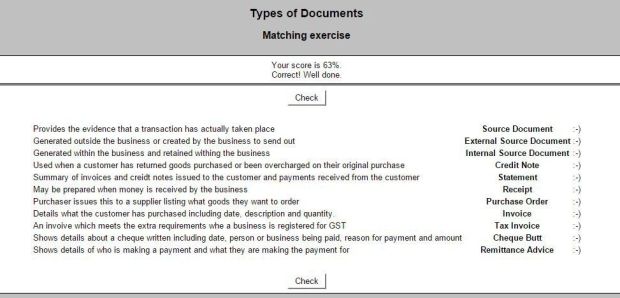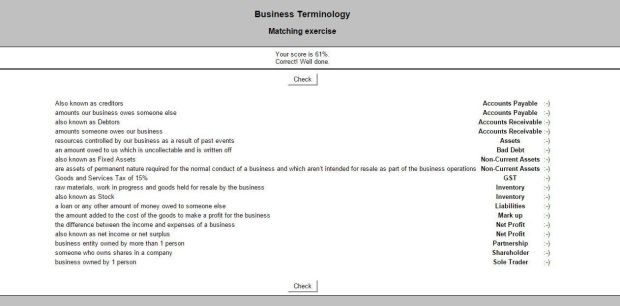Part 1. Types of Documents Activity
Demonstrating my stupendous ability to decipher complicated words.

Documents
- Cheque Butt – Shows details about a cheque written including date, person or business being paid, reason for payment and amount
- Credit Note – Used when a customer has returned goods purchased or been overcharged on their original purchase
- External Source Document – Generated outside the business or created by the business to send out
- Internal Source Document – Generated within the business and retained within the business
- Invoice – Details what the customer has purchased including date, description, and quantity
- Purchase Order – Purchaser issues this to a supplier listing what goods they want to order
- Receipt – Maybe prepared when money is received by the business
- Remittance Advice – Shows details of who is making a payment and what they are making the payment for
- Source Document – Provides the evidence that a transaction has actually taken place
- Statement – Summary of invoices and credit notes issued to the customer and payments received from the customer
- Tax Invoice – An invoice which meets the extra requirements when a business is registered for GST
Part 2. Business Terminology Activity
Confirming my phenomenal abilities by interpreting some more complex words.

Terms
- Accounts Payable – also known as Creditors
- Accounts Payable – amounts our business owes someone else
- Accounts Receivable – also known as Debtors
- Accounts Receivable – amounts someone owes our business
- Assets – resources controlled by our business as a result of past events
- Bad Debt – an amount owed to us which is uncollectible and is written off
- Non-Current Assets – also known as Fixed Assets
- Non-Current Assets – are assets of permanent nature required for the normal conduct of a business and which aren’t intended for resale as part of the business operations
- GST – Goods and Services Tax of 15%
- Inventory – raw materials, work in progress and goods held for resale by the business
- Inventory – also known as Stock
- Liabilities – a loan or any other amount of money owed to someone else
- Mark up – the amount added to the cost of the goods to make a profit for the business
- Net Profit – the difference between the income and expenses of a business
- Net Profit – also known as net income or net surplus
- Partnership – business entity owned by more than 1 person
- Shareholder – someone who owns shares in a company
- Sole Trader – business owned by 1 person
Part 3. Document Flow Activity
From Purchase Orders to Payment, how basic Business Purchasing works.

Business A prepares a purchase order which it sends to Business B.
Business B receives the purchase order from Business A, locates the goods and packages them up to send to Business B. Business B also prepares an invoice which they may use as a packing slip as well. The invoice could be sent with the goods or sent at a later date to Business A.
When Business A receives the invoice and goods they will compare what has been sent is what they ordered by comparing them to the purchase order copy they kept.
When Business A confirms they have received what they ordered, they will pay the invoice using a cheque or paying online. They may also send back a remittance advice so business B knows who the payment comes from.
When business B receives the payment from Business A they may issue a receipt
Business B will bank any cheques/payments they have received into their bank account.
If Business A has not paid by the end of the month, Business B may send a statement which shows amount still owing by Business A.
Sometimes Business B may issue a credit note if the items sent to Business A are damaged or missing.
Part 4. IRD Links
Turning words into links, this stuff is crazy…
And some more for fun.
Part 5. Reflection

Image from: http://blog.strideapp.com/wp-content/uploads/2014/05/shutterstock_157130165.jpg (08/03/2016) – Quote added by me, I’m sure I’ve heard it somewhere but cannot find a reference.
Whether you’re a cleaner and only need to know if you’re on the correct tax code and what documents not to throw out or you’re a CEO who needs to know how every aspect of your company works, I believe when entering a position within a business, regardless of your role, it is important to have at least some understanding of how that business operates and clearly working as an IT professional is no exception.
So what does the above quote mean? I have been working in professional environments for the past 8 years, in that time I have had many roles; Sales Consultant, Store Person, Administrator and even worked in Management, In each and every one of these roles I have found that my performance has been greatly affected by my knowledge of certain business terms and the documents we used, but it was not only my own knowledge that made a difference, particularly in the latter 3 of my roles, it was my co-workers knowledge on these subjects that had the greater impact. An example of this is while I was working as a Store Person, the number of times I witnessed the effect of a Sales Consultant placing an order incorrectly is phenomenal, the result of this usually ended with an angry and unsatisfied customer, not to mention the larger impact of losing that sale along with potentially any future sales to that customer and anyone they happened to share the details of their bad experience with. This was not entirely the Sales Consultants fault mind you, they were all well trained and had excellent ability in sales techniques, the real issue was a lack of training, knowledge and most importantly an understanding of the business terms and document flow. To explain further, every person (every cog) has the potential to affect the business (the machine) in a positive way (a well-oiled cog) or a negative way (a broken cog) depending not only on their abilities specific to their role but also whether they have a greater understanding of how the business works.
In conclusion, when working as an IT professional, or in any business environment for that matter, it does not matter if you’re an employee in a company or self-employed and working with clients, understanding business terms and document flow is an extremely important skill. You could be the best programmer or designer in the world but failing to understand these concepts could impinge your ability to effectively meet your employers or clients’ needs and even leave your own business in ruins.
Brilliant reflection and I love the way you have used your own experiences to confirm the importance of this area which many IT students would just prefer not to know anything about!
LikeLike